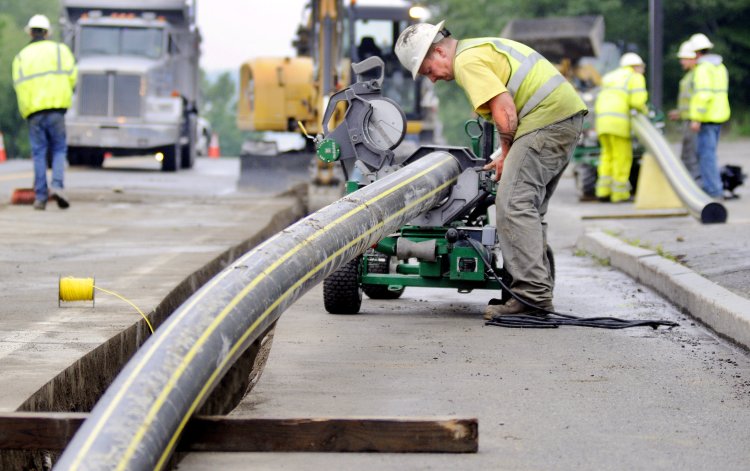
An oil tanker hooks up to an offshore station that pipes crude oil underground to large storage tanks in St. John, Nova Scotia. Fuel and oil are Maine’s biggest imports from Canada and could be hard hit by a proposed 25% tariff. Gordon Chibroski/Portland Press Herald file
Tariffs that are central to President Donald Trump’s economic policies could destabilize markets for many Maine products from lumber to lobsters to electricity.
The president has said he will impose tariffs of 25% of the value of a product imported from Mexico and Canada beginning Saturday. His reasons are numerous: to prod businesses to move production to the U.S.; to punish trading partners he says are unfairly competing against the U.S. because of policies, such as government subsidies, that distort markets; to raise revenue; and to pressure governments to negotiate on issues such as illegal immigration.
Speaking by video at the World Economic Forum in Davos, Switzerland, on Jan. 23, Trump urged business leaders to manufacture their products in America “and we will give you among the lowest taxes of any nation on Earth.
“But if you don’t make your product in America, which is your prerogative, then very simply you will have to pay a tariff,” he said.
Essentially a tax, a tariff could lead to higher prices because businesses typically pass the cost onto consumers, fueling inflation, critics say. Another rap against tariffs is that they lead to inefficiencies if consumers buy products that are not hit with tariffs rather than purchase the best product available or get the best value for their money. And they drive other countries to respond with a tax on U.S. goods.
Last year, Maine imported $6.2 billion of goods, according to the U.S. Department of Commerce, though data from December is not yet available. In 2023, Maine imported $7.3 billion, nearly double from $4 billion in 2014, according to the U.S. International Trade Administration.
MAINE ‘SO INTEGRATED’ WITH CANADA
Tariffs on products from Canada, which is Maine’s biggest trading partner, would send powerful ripples across the state’s economy.
Maine brought in $4.4 billion of goods – fuels, oil, electricity, wood pulp and more – from its neighbor in 2024. Imports from Canada far outpace those from any other trading partner, with China, the next largest, sending $165 million worth of products to Maine in 2024, followed by Germany at $137 million.
Maine’s relationship with its neighbor to the north is measured in more than dollars, said Patrick Woodcock, president and CEO of the Maine State Chamber of Commerce. Many state businesses see Canada not just as a market to buy and sell items, but a place with mills and processing plants that are “fully integrated in their business plans,” he said.
“It is a relationship so integrated into the Maine economy,” Woodcock said. The state is “particularly vulnerable to a tariff” as a result.
“If it’s across the board it would be a dramatic jolt to existing businesses,” he said.
Overall, about 14,000 jobs in the state were supported by Maine exports in 2021, or about 2% of the state’s labor force and down from nearly 17,000 in 2013, according to the most recent data provided by the International Trade Administration. The loss of paper manufacturing jobs contributed significantly to the employment drop, said Glenn Mills, deputy director of the Center for Workforce Research at the state Department of Labor.
LUMBER TARIFF ALREADY IN EFFECT
New tariffs could complicate trade relations between the U.S. and Canada, which have been tested in disputes over lumber for decades, said Patrick Strauch, executive director of the Maine Forest Products Council. An additional charge slapped on products could be harmful in an industry struggling because of high interest rates that are slowing home construction, a major driver of lumber sales.
“When your industry is in a depressed condition, you don’t need this,” Strauch said.

A worker restocks the drive-thru warehouse at Hammond Lumber in Portland in 2017. Lumber tariffs in effect since 2017 have already tested Maine’s relationship with Canada. Derek Davis/Portland Press Herald file
Since the expiration of a U.S.-Canada softwood lumber agreement in 2016, countervailing duties of 14.4% have been applied to Canadian lumber imports. A formula was worked out with the U.S. Department of Commerce following years of complaints by some on the U.S. side of the border that Canada has been subsidizing producers, giving an unfair advantage to competitors of U.S. lumber, Strauch said.
“This is something different, a 25% tariff based on no measurement,” he said. “We didn’t come out with a strong statement, but in general, we’re concerned because a lot of factors are involved.”
FUEL AND ELECTRICITY
While Maine’s relationship with Canada has been tested with tariffs on lumber, a universal tariff would have the biggest effect on the price of energy.
Fuel and oil are the state’s largest imports from Canada, amounting to $2.5 billion last year, according to the U.S. Department of Commerce. That’s nearly 10 times the value of wood pulp imports, the second costliest item Maine gets from Canada. And much greater than the $212.3 million of imported electricity.
Trump said Thursday he is still deciding whether to include oil in the tariffs.
Maine has no petroleum, natural gas or fossil fuel reserves, and it doesn’t produce or refine those materials. Yet about half of Maine households use petroleum products, primarily heating oil or propane, for home heating. It’s a larger share than in any other state, according to the U.S. Energy Information Administration.
Power plants also burn large amounts of natural gas to generate electricity. One of the biggest pipelines in New England — the 684-mile Maritimes & Northeast line that roughly follows Interstate 95 in Maine — draws natural gas from sites off the coast of Nova Scotia. If it costs power plants more money to turn that gas into electricity, ratepayers are likely to be on the hook.
In a Jan. 21 memo to state legislators, Maine’s outgoing public advocate, William Harwood, said he’s uncertain about exactly when and how a tariff would be applied “because of the novelty of the issue.”


Workers with Bowdoin Excavation lay gas pipes in Augusta for Maine Natural Gas in 2013. Andy Molloy/Kennebec Journal file
He said thousands of people in northern Maine could see higher power bills for a different reason — because that part of the state is connected to New Brunswick’s electric grid instead of New England’s.
Customers in Aroostook and Washington counties served by Versant Power, Houlton Water Co., Van Buren Light & Power District and Eastern Maine Electric Cooperative would be affected. Those utilities import approximately 600,000 megawatt-hours of electricity each year to serve 58,000 ratepayers, Harwood said.
A 25% tariff will cost ratepayers about $8 million to $10 million a year, or an average of between $6 and $7 a month more in utility bills, he said. That would represent a 5% jump in electricity bills, he said.
“Some of the poorest people in the state live in Washington and Aroostook counties,” he said in a recent interview.


A dump truck navigates a steep hill along the NECEC corridor in Johnson Mountain Township in November 2021. The transmission line is expected to start bringing hydropower from Canada to New England next year, and universal tariffs would increase the price of that electricity. Gregory Rec/Portland Press Herald file
A tariff also would be slapped on electricity transmitted along the New England Clean Energy Connect, the 145-mile transmission line being built to bring hydropower from Canada to the New England electricity grid via western Maine, Harwood said. “The magnitude of the hit to the new England market is big,” he said.
The project, which will transmit 1,200 megawatts, is expected to come online in 2026 and could power as many as 1.2 million homes, according to developer Avangrid Inc. About 33% of construction is complete.
Massachusetts Gov. Maura Healey told business leaders on Jan. 23 that a 25% tariff on products from Canada could boost electricity costs by as much as $200 million a year. Her office said the cost calculation is based on the Bay State’s use of nearly half of New England’s electricity.
“We don’t need an additional tax and tariffs on electrons in any form, whether it’s hydro from Canada or other things that are coming in,” the governor said.
RETALIATORY LOBSTER TARIFFS
Retaliatory tariffs also loom as a threat in response to U.S. actions. Retaliatory tariffs by China seven years ago damaged the state’s lobster industry. Live lobster exports from Maine and Massachusetts to China plunged to $1.4 million in 2018 from $8.1 million the previous year, a nearly 83% drop.
“We benefited from that one,” said Geoff Irvine, executive director of the Lobster Council of Canada, an industry group. “Because your tariffs were higher than ours.”
A 25% tariff would lead to higher prices and cut lobster sales in the U.S., he said. “Will American consumers pay 25% more for lobsters? I don’t know. I’m hearing they won’t.”


Lobsters sit in a crate at a shipping facility in November 2020 in Arundel. AP Photo/Robert F. Bukaty
“Everybody will suffer, including consumers who will pay more,” Irvine said.
The lobster industry has lobbied against retaliatory tariffs that Irvine said would reduce the work of Canadian plants that process Maine lobsters.
In addition, several U.S. companies operate processing plants in Canada, and their prices will immediately rise by 25%, Irvine said.
Between Maine and Canada, the industries are “so intertwined,” with trade, processing and seasonal differences that complement lobster fishing by the two nations, said Marianne LaCroix, executive director of the Maine Lobster Marketing Collaborative.
“It is a bit of an unknown,” she said of a possible tariff and a response. “When it would happen, if it would happen, if Canada retaliates.”
SUPPORT IN CONGRESS
Tariffs have their supporters. U.S. Reps. Jared Golden and Chellie Pingree, both Democrats, back measures to protect Maine businesses that could benefit from tariffs on imports making the price of domestic products more attractive.
“I see the value of more protectionism,” Pingree said. “I think there aren’t enough areas where we protect our manufacturing and economy.”
She does not, however, support legislation proposed by Golden to establish a 10% tariff on all imported goods. Although he is “writing a bill trying to respond to a general feeling of worry,” Pingree said her colleague’s measure “seems like a meat cleaver, not a scalpel.”
Sen. Susan Collins also opposes Golden’s legislation, saying a 10% tariff would impose added costs for consumers and businesses.
She said she opposes “harmful retaliatory tariffs that have the potential to disrupt Maine’s access to the global marketplace.” The authority to set tariffs is “largely delegated” to the president, she said.
“I will work with the Trump administration to ensure they know how important trade is for Maine, especially our trade relationship with Canada,” Collins said.
Wade Merritt, president of the Maine International Trade Center, said he’s fielding calls from businesses asking how they might manage tariffs that could be established any day.
Businesses that face tariffs on their products that make them costlier for consumers and therefore less attractive, might look to develop strategies such as absorbing the additional costs by adjusting to a reduced profit, renegotiating contracts with suppliers, finding new supply sources and returning some production to the U.S., he said.
“It’s still kind of wait and see, what companies need to react to,” he said. Uncertainty is “the hard part.”
“There are a lot of pieces out there,” he said. “The question is how do we best respond to them.”
Send questions/comments to the editors.



We invite you to add your comments. We encourage a thoughtful exchange of ideas and information on this website. By joining the conversation, you are agreeing to our commenting policy and terms of use. More information is found on our FAQs. You can modify your screen name here.
Comments are managed by our staff during regular business hours Monday through Friday as well as limited hours on Saturday and Sunday. Comments held for moderation outside of those hours may take longer to approve.
Join the Conversation
Please sign into your CentralMaine.com account to participate in conversations below. If you do not have an account, you can register or subscribe. Questions? Please see our FAQs.